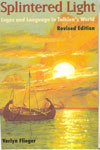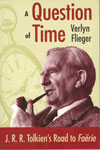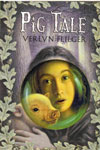SPECIAL GUEST:
Q&A with Verlyn Flieger
Verlyn Flieger is a well-known Tolkien scholar, with three books on Tolkien to her credit. The first, Splintered Light: Logos and Language in Tolkien's World, came out in 1983. Her second, A Question of Time: J. R. R. Tolkien's Road to Faerie (1997) (ISBN 087338699X, trade paperback $18.00), won the Mythopoeic Scholarship Award (from the Mythopoeic Society, see: http://www.mythsoc.org/), as did her third book, Tolkien's Legendarium: Essays on The History of Middle-earth (2000) (ISBN 0313305307, hardcover $62.95), which she co-edited with Carl F. Hostetter.
In the last month Flieger has published not one but two new books. The first is a major revision of her first book on Tolkien, Splintered Light (ISBN 0873387449, trade paperback $19.00), while the second is her first novel, Pig Tale (ISBN 078680792X, hardcover $16.99). The publisher of the novel, Hyperion, describes it as follows: "Verlyn Flieger weaves elements from Celtic mythology into an unforgettable tale that explores universal truths about the human condition--society's need for scapegoats, the yearning to belong, and love's transcendent power to make the world anew. Thought-provoking, unflinching and original, Pig Tale will break your heart, and utterly astonish you."
Verlyn Flieger teaches Tolkien and mythology at the University of Maryland. Check out her website at: http://www.mythus.com/. Meanwhile Flieger has kindly agreed to discuss her new books with me, and our question and answer session follows.
Q.Tell us about your new edition of Splintered Light. What is the central thesis of the book, and how does the new edition differ from the first?
A. I'll answer the last question first. The new edition simply has more information, and therefore gives a richer picture. So much more of Tolkien's work has been published than was accessible when my book first came out in 1983 -- the whole History of Middle-earth, twelve volumes detailing the growth of a mythology. In especial, there's more linguistic material available, and I was able to cross-check and in some cases emend things I had written earlier. So I've greatly expanded the linguistic discussion. I've also gone into detail on the influence of the discipline of folklore studies, which was in a state of flux when Tolkien was beginning work on his mythology. The whole subject was in ferment, and there was enormous theoretical disagreement among folklorists. You can find Tolkien's take on the whole controversy in his essay "On Fairy-stories," where he shoots down the current theories and then provides his own. And of course, his own work is the best illustration of what he thought mythology was and what it was for. But re-reading and revising Splintered Light after twenty or so years, I had to scrutinize just about every sentence and test every conclusion to keep myself and the book honest.
Now, what is the central theme of the book? That hasn't changed. It's the importance, indeed the centrality, of language to the process of world-making that Tolkien calls sub-creation, and the parallel divisions of light, language, and peoples into smaller and more discrete units as the world grows and complicates. The central image of primary light refracted into colors stands for the whole splintering. Things are broken apart, yet out of this great and unexpected beauty is created. Tolkien drew on the work of Owen Barfield, whose Poetic Diction explores the fragmentation of meaning, the shift from literal meaning to metaphor, and the effect of that shift on perception.
Q. Can you also describe A Question of Time for those of our readership who might not already know about it?
A. That's a bit more complicated. When I visited the Marquette University Archive in 1984, the late and lamented Taum Santoski pointed out to me a note Tolkien had pencilled in the margin of a draft of the Lorien chapter about the difference between time in the outside world and timelessness in Lorien. I'd never noticed any discrepancy, but when I looked back at the published book I saw that Tolkien was so to speak, playing with time, suggesting that there could be different perceptions of time and different relationships to it. When I mentioned this to Priscilla Tolkien, she put me on to a book her father had read called An Experiment With Time by J.W. Dunne that was actually rather popular in England in the 'thirties. C.S. Lewis knew it. J.B. Priestly based some plays on it, James Hilton mentioned it in several of his novels, and Rumer Godden built a whole novel around it. Dunne's book was about predictive dreams and the ability of the dreaming mind to move backward and forward in time as we conventionally move in space. I found evidence that Tolkien was using Dunne's theory to contrast Elves and Men in his Secondary World, and that his treatment of time in The Lord of the Rings was very subtly consistent with Dunne's theory. That led me to a consideration of Tolkien in his own time, the twentieth century, and how much he was tied to it even as he tried through his fiction to escape it. So the question of time is not only how we relate to time in a metaphysical sense, but how Tolkien related to his own time. Somehow I found a way to tie those two things together, and that's what the book is about.
Q. And while we are at it, give us the scoop on the collection you co-edited with Carl F. Hostetter, Tolkien's Legendarium.
A. It began as a Festschrift for Christopher Tolkien on the completion of The History of Middle-earth. Carl and I were looking for a way to acknowledge this huge work -- twelve volumes and twenty years of unremitting labor -- and honor Christopher's contribution to Tolkien Studies. Carl suggested a Festschrift, and when we approached contributors they were enthusiastic about the project. Not so publishers. Rayner Unwin had warned us that festschriften were box office poison, so to speak. That is, no publisher would touch one because they were hard to sell. But Greenwood Press told us they would accept the book if we took out the word festschrift. We did and they did, and it's gone through several printings. So without the F-word it wasn't hard to sell. To my knowledge, it's the only collection that focuses on The Silmarillion and the larger issues of Tolkien's mythology, so we hope that it makes a useful contribution to Tolkien scholarship. We meant it to cover a broad range of things, so it runs the gamut from general overviews of the mythology to studies of individual stories to highly specific analyses of Tolkien's prosody, and the construction and components of his Elven languages.
Q. Your novel, Pig Tale, has an almost friendly-looking cover for the young girl's harrowing story found inside. Can you tell us a bit about the novel, and its genesis?
A. It began with a scene that I saw in my mind's eye -- three people, a woman and two men seated around a candle-lit table with their shadows looming on the wall. I knew their names -- Lally Dai, The Skimmer, Dogger John -- but I didn't know who they were or why they were there. I had to listen to their conversation to find out. Then my protagonist, Mokie, the girl on the friendly cover, sort of dropped in from a short story I'd been writing, a kind of fairy tale about a misfit girl who minded pigs. After that the story took charge. I don't mean that it wrote itself; it involved a lot of hard work and re-writing. But I did just follow where it led.
Q. How long did it take you to write it?
A. In calendar time, about five or six years. In actual time of concentrated work, much shorter -- maybe a year or a little more. That's because I let it languish for long periods while I was doing other things. I'd put it away and forget about it, and then get an impulse or an idea or a bit of dialogue, and pull it out and work on it for a couple of weeks in my spare time. Writing fiction is a guilty pleasure for me. It's what I do when I know I should be doing other things like grading exams or preparing for class or cleaning house. Instead I play hooky and write stories.
Q. Do you have any other Tolkien-related works in progress?
A. Yes. I'm getting more and more interested in how Tolkien's work relates to the use of myth in the development of nationalism -- remember he wanted to dedicate a mythology to England (not Britain) -- and how it reflects the darker aspects of the twentieth century -- the two World Wars and their psychological aftermath, their effect on art and literature. Tolkien saw combat in World War I, and if you think about it, all his long fiction, The Hobbit, The Silmarillion, The Lord of the Rings, is about war. The Silmarillion is one long war beginning with the return of the Noldor to Middle-earth -- huge battles punctuated with uneasy lulls and guerilla warfare. The Hobbit starts out as a parodic fairy tale and ends up with The Battle of Five Armies, It's a story about how wars are triggered, how politics makes strange bedfellows, the varying reasons why wars are fought, who seeks to profit, and how lives are sacrificed to somebody's greed. Bilbo's stealing of the cup from Smaug is like the gunshot at Sarajevo, it embroils groups of unrelated peoples (or wolves and goblins) in an escalating conflict. The Master of Lake-town is a war profiteer, a politician making the most of whatever opportunity comes along. Fili and Kili are killed defending Thorin, and Thorin, whose quest to regain the gold started the whole thing, doesn't get what he went for. It's like World War I -- four years of slaughter with no advantage to either side, and at the end everything went back to where it was -- except people's lives, which were irrevocably changed. And The Lord of the Rings is war as past history (the Dead Marshes and the Grey Company), war preparing (Frodo's vision on Amon Hen), war imminent (Eomer's and Faramir's skirmishes on the border), war happening in all its horror (flame throwers at Helm's Deep and severed heads as ammunition at the Siege of Gondor). And then the predictable aftermath, the degradation of the Shire. Like the War Poets, Siegfrid Sassoon, Wilfrid Owen, people like that, Tolkien couldn't help writing about war. But he transmuted it into fantasy as a way to deal with what is essentially unbearable.
Q. Last, any comments on Peter Jackson's film of The Fellowship of The Ring?
A. I didn't like it. But then, it wasn't aimed at me. It was aimed at the generations who've grown up on Star Wars and hunger for more and more action and greater and greater special effects. Jackson has turned an extremely sophisticated, complex and subtle -- and very long -- story into an action movie that I think satisfies the audience for whom he made it. The time constraint that film format enforces makes it almost certain that, even making three separate films Jackson cannot get the fullness of Tolkien's story into a movie. Three hours of sitting it about the outside limit. After that your bum gets numb. I felt some parts were disastrously miscast, Elrond for example. Not the actor's fault, though if I'd been him I wouldn't have stood for that hairdo. Elijah Wood is just wrong for Frodo -- too young, too pretty, too goggle-eyed. And the script gave the character no chance to develop. His moments of growth in the barrow was omitted; his bravery when he turns and faces the Black Riders at the Ford was left out in favor of Arwen as Our Lady of the Ford. Galadriel was terrible, and since Cate Blanchett is a fine actor, she must have been directed to perform in that wooden, zombie-like manner. Sean Bean is the only person who played as if he believed who he was. His Boromir was a real person, not a type. I found him totally convincing, and his funeral journey down the river and over the falls was the film's finest moment. Truly moving. Although the script sentimentalized and overdid the character's repentance at the end. Boromir is not that good. As for un-Tolkienian lines like Gimli's "Nobody tosses a dwarf," and Strider's "Let's hunt some orc," they are beyond comment.
--Turgon
|
![[ Green Books ]](http://img-greenbooks.theonering.net/images/gb_logo.gif)
![[ Green Books - Exploring the Words and Worlds of J.R.R. Tolkien ]](http://img-greenbooks.theonering.net/images/gb_topnav.gif)



